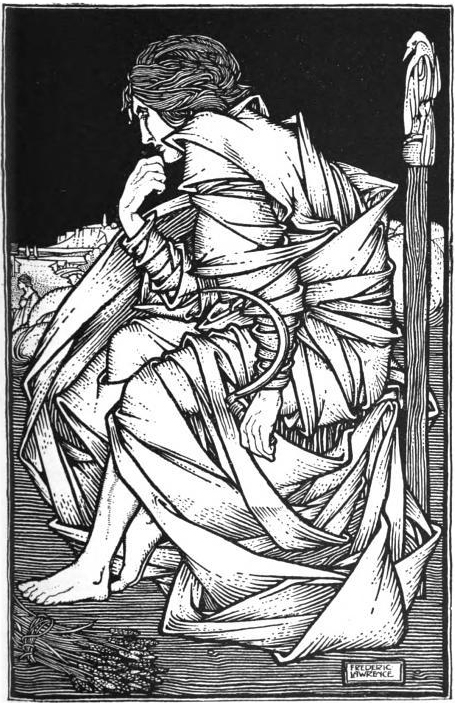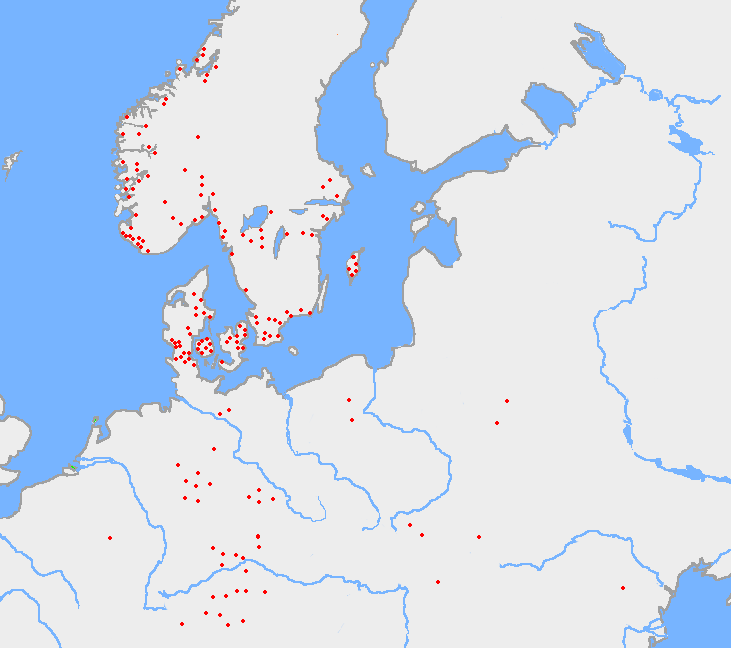|
Yngvi
Old Norse Yngvi , Old High German Ing/Ingwi and Old English Ing are names that relate to a Lists of deities, theonym which appears to have been the older List of names of Freyr, name for the god Freyr. Proto-Germanic language, Proto-Germanic Ingwaz was the legendary ancestor of the Ingaevones, or more accurately ''Ingvaeones'', and is also the reconstructed name of the Elder Futhark runes, rune ᛜ and Anglo-Saxon runes, Anglo-Saxon rune ᛝ, representing ''ŋ''. Etymology Old Norse ''Yngvi'' as well as Old High German ''Inguin'' and Old English ''Ingƿine'' are all derived from the Proto-Germanic language, Proto-Germanic *Ingwaz. Sound changes in late-Proto-Germanic transformed *Ingwaz into *Ingwi(z) in the nominative case and *''Ingwin'' in the accusative case. His epithet *Fraujaz appears in Old Norse compounds ''Ingvifreyr'' and ''Ingunarfreyr''. In Beowulf we see Hrothgar called (OE) ''fréa inguina'', which means 'Lord of the Inguins', i.e. lord of the Ingvaeones, the 'fri ... [...More Info...] [...Related Items...] OR: [Wikipedia] [Google] [Baidu] |
Yngling
The Ynglings were a dynasty of kings, first in Sweden and later in Norway, primarily attested through the poem ''Ynglingatal''. The dynasty also appears as Scylfings (, ) in ''Beowulf''. When ''Beowulf'' and ''Ynglingatal'' were composed sometime in the eighth to tenth centuries, their respective authors (scops and skalds) expected their audience to have a great deal of background information about these kings, which is shown in the allusiveness of the references. According to sources such as ''Ynglingatal'' and ''Íslendingabók'', the Fairhair dynasty in Oppland, Norway was in fact a branch of the Ynglings (here Yngling is explicitly used as the name of the dynasty). Saxo Grammaticus held that the Ynglings also included Eric the Victorious, who is usually the first king in modern regnal lists, and his House of Munsö, descendants. However, this does not tally with Icelandic sources. The dynasty claimed descent from the gods Freyr and Njörðr, and other kings were likely mythic ... [...More Info...] [...Related Items...] OR: [Wikipedia] [Google] [Baidu] |
Freyr
Freyr (Old Norse: 'Lord'), sometimes anglicized as Frey, is a widely attested Æsir, god in Norse mythology, associated with kingship, fertility, peace, prosperity, fair weather, and good harvest. Freyr, sometimes referred to as Yngvi-Freyr, was especially associated with Sweden and seen as an ancestor of the Yngling, Swedish royal house. According to Adam of Bremen, Freyr was associated with peace and pleasure, and was represented with a phallus, phallic statue in the Temple at Uppsala. According to Snorri Sturluson, Freyr was "the most renowned of the æsir", and was venerated for good harvest and peace. In the mythological stories in the Icelandic books the ''Poetic Edda'' and the ''Prose Edda'', Freyr is presented as one of the Vanir, the son of the god Njörðr and Sister-wife of Njörðr, his sister-wife, as well as the twin brother of the goddess Freyja. The gods gave him Álfheimr, the realm of the Álfar, Elves, as a teething present. He rides the shining Norse dwarves, ... [...More Info...] [...Related Items...] OR: [Wikipedia] [Google] [Baidu] |
List Of Names Of Freyr
The Germanic god Freyr is referred to by many names in Old Norse poetry and Old Norse literature, literature. Multiple of these are attested only once in the extant record and are found principally in Skáldskaparmál. Some names have been further proposed by scholars to have referred to the god in the Medieval period, including one from Old English literature. Names Proposed names Scholars have proposed names that may have been used historically to refer to Freyr. In contrast to the first table, these names rely to varying extents on speculation and are not unequivocal. See also *List of names of Odin *List of names of Thor *Names of God in Old English poetry References Bibliography Primary * * * * * * * ≈ * * * * * * * * * * * Secondary * * * * * * * * * * {{Norse paganism topics Germanic paganism and mythology lists, Freyr, names of Freyr, * Epithets of Germanic deities, Freyr Masculine names ... [...More Info...] [...Related Items...] OR: [Wikipedia] [Google] [Baidu] |
Ingaevones
The Ingaevones () or Ingvaeones () were a Germanic peoples, Germanic cultural group living in the Northern Germania along the North Sea coast in the areas of Jutland, Holstein, and Lower Saxony in classical antiquity. Tribes in this area included the Angles (tribe), Angles, Chauci, Saxons, and Jutes. The name is transmitted in two different forms in ancient sources: Tacitus provides the form , while Pliny the Elder has . Most scholars derive the name from the god or hero attested under the name Yngvi in later Norse sources, and thus believe Pliny's form is the original one. Hence the postulated common group of closely related dialects of the "Ingvaeones" is called Ingvaeonic or North Sea Germanic. Tacitus' source categorized the ''Ingaevones near the ocean'' as one of the three tribal groups descended from the three sons of Mannus, son of Tuisto, progenitor of all the Germanic peoples, the other two being the ''Irminones'' and the ''Istaevones''. According to the speculations of ... [...More Info...] [...Related Items...] OR: [Wikipedia] [Google] [Baidu] |
Yngve Frey Bygger Gamla Upsala Tempel By Hugo Hamilton
Yngve is a Scandinavian male given name, mostly used in Sweden and Norway. It is the modern form of either Old Norse Yngvi or of Ingwin. ''Yngvi'' was the Old Norse name of the Germanic god ''Ingu-'', later identified with Freyr, or of ''Ingwian-'' "belonging to the tribe of the Ingvaeones" (who were in turn named after ''Ingu-''. The name is most common among Swedish men over the age of 50, and occurs almost exclusively as a middle name among the youngest. Due to its Viking origins, the name was very popular during the 19th century and the national romantic era. As of 31 December 2005, there are a total of 18,578 Swedes with the name, of which 4756 use it as their main first name. As of 1 January 2006 there are 2370 Norwegians with Yngve as their first name, 1924 of whom use it as their only first name. In Finland there are 1046 people named Yngve. [...More Info...] [...Related Items...] OR: [Wikipedia] [Google] [Baidu] |
Fraujaz
*''Fraujaz'' or *''Frauwaz'' (Old High German ''frô'' for earlier ''frôjo, frouwo'', Old Saxon ''frao, frōio'', Gothic ''frauja'', Old English ''frēa'', Old Norse ''freyr''), feminine *''Frawjōn'' (OHG ''frouwa'', Old Saxon ''frūa'', Old English ''frōwe'', Goth. *''fraujō'', Old Norse ''freyja'') is a Common Germanic honorific meaning "lord", "lady", especially of deities. The epithet came to be used as a proper name of two separate deities in Norse mythology, Freyr and Freyja. Etymology The term's etymology is ultimately from a PIE ''*pro-w-(y)o-s'', containing ''*pro-'' "in front" (cf. ''first'', ''Fürst'' and Sanskrit '' purohita'' "high priest", lit. "placed foremost or in front"). Variants indicate ''n''-stems ''*fraujan-'', ''*frōwōn-''. The feminine *''frawjōn'' "lady, ''domina''" in Old English is attested only in a single isolated occurrence as ''frēo'' "woman" in the translation of the fragmentary Old Saxon ''Genesis'' poem, in the alliterating phrase ' ... [...More Info...] [...Related Items...] OR: [Wikipedia] [Google] [Baidu] |
Inguiomerus
Inguiomer or Ingomar (; fl. 1st century AD) was a leader of the Cherusci. He is chiefly remembered as the uncle of Arminius. Name Alexander Haggerty Krappe proposed the name derives from Old Germanic , related to Yngvi, the older name of the Germanic god Freyr.. Life Inguiomer was the brother of Segimer, a chieftain of the Germanic Cherusci tribe. This made him the uncle of Arminius and Flavus. Inguiomer is mentioned in Tacitus's account of the Roman reprisal campaigns of Germanicus against the Germans after their defeat at Teutoburg Forest. In AD15, he is mentioned arguing against Arminius's defensive strategy. He pursued the retreating army of Caecina across rough terrain, suffering a defeat in which he was personally wounded. Inguiomer is also mentioned joining the Marcomanni chieftain Maroboduus in his war against Arminius in AD17 or 18. He died at some point before AD47, when the Cherusci are recorded appealing to Rome for Inguiomer's grandnephew Italicus as the only ... [...More Info...] [...Related Items...] OR: [Wikipedia] [Google] [Baidu] |
Anglo-Saxon Runes
Anglo-Saxon runes or Anglo-Frisian runes are runes that were used by the Anglo-Saxons and Medieval Frisians (collectively called Anglo-Frisians) as an alphabet in their native writing system, recording both Old English and Old Frisian (, ᚱᚢᚾᚪ, "rune"). Today, the characters are known collectively as the futhorc (ᚠᚢᚦᚩᚱᚳ, ''fuþorc'') from the sound values of the first six runes. The futhorc was a development from the older Germanic peoples, co-Germanic 24-character runic alphabet, known today as Elder Futhark, expanding to 28 characters in its older form and up to 34 characters in its younger form. In contemporary Scandinavia, the Elder Futhark developed into a shorter 16-character alphabet, today simply called Younger Futhark. Use of the Anglo-Frisian runes is likely to have started in the 5th century onward and they continued to see use into the High Middle Ages. They were later accompanied and eventually overtaken by the Old English Latin alphabet introdu ... [...More Info...] [...Related Items...] OR: [Wikipedia] [Google] [Baidu] |
Njörðr
In Norse mythology, Njörðr (Old Norse: ) is a god among the Vanir. Njörðr, father of the deities Freyr and Freyja by Sister-wife of Njörðr, his unnamed sister, was in an ill-fated marriage with the goddess Skaði, lives in Nóatún (mythology), Nóatún and is associated with the sea, seafaring, wind, fishing, wealth, and crop fertility. Njörðr is attested in the ''Poetic Edda'', compiled in the 13th century from earlier traditional sources, the ''Prose Edda'', written in the 13th century by Snorri Sturluson, in euhemerized form as a beloved mythological early king of Sweden in ''Heimskringla'', also written by Snorri Sturluson in the 13th century, as one of three gods invoked in the 14th century ''Hauksbók'' Almáttki áss, ring oath, and in numerous Scandinavian toponymy, place names. Veneration of Njörðr survived into the 18th or 19th century Norway, Norwegian folk practice, where the god is recorded as Njor and thanked for a bountiful catch of fish. Njörðr has ... [...More Info...] [...Related Items...] OR: [Wikipedia] [Google] [Baidu] |
Elder Futhark
The Elder Futhark (or Fuþark, ), also known as the Older Futhark, Old Futhark, or Germanic Futhark, is the oldest form of the runic alphabets. It was a writing system used by Germanic peoples for Northwest Germanic dialects in the Migration Period. Inscriptions are found on artifacts including jewelry, amulets, plateware, tools, and weapons, as well as runestones, from the 2nd to the 8th centuries. In Scandinavia, beginning in the late 8th century, the script was simplified to the Younger Futhark, while the Anglo-Saxons and Frisians instead extended it, giving rise to the Anglo-Saxon runes, Anglo-Saxon futhorc. Both the Anglo-Saxon futhorc and the Younger Futhark remained in use during the Early Middle Ages, Early and the High Middle Ages respectively, but knowledge of how to read the Elder Futhark was forgotten until 1865, when it was deciphered by Norwegian scholar Sophus Bugge. Description The Elder Futhark is named after the initial phoneme of the first six rune names: /f/ ... [...More Info...] [...Related Items...] OR: [Wikipedia] [Google] [Baidu] |
Runes
Runes are the Letter (alphabet), letters in a set of related alphabets, known as runic rows, runic alphabets or futharks (also, see ''#Futharks, futhark'' vs ''#Runic alphabets, runic alphabet''), native to the Germanic peoples. Runes were primarily used to represent a sound value (a phoneme) but they were also used to represent the concepts after which they are named (ideographic runes). Runology is the academic study of the runic alphabets, runic inscriptions, runestones, and their history. Runology forms a specialised branch of Germanic philology. The earliest secure runic inscriptions date from at latest AD 150, with a possible earlier inscription dating to AD 50 and Tacitus's possible description of rune use from around AD 98. The Svingerud Runestone dates from between AD 1 and 250. Runes were generally replaced by the Latin alphabet as the cultures that had used runes underwent Christianisation, by approximately AD 700 in central Europe and 1100 in northern Europe. Ho ... [...More Info...] [...Related Items...] OR: [Wikipedia] [Google] [Baidu] |
Runic Letter Ingwaz
Runes are the letters in a set of related alphabets, known as runic rows, runic alphabets or futharks (also, see ''futhark'' vs ''runic alphabet''), native to the Germanic peoples. Runes were primarily used to represent a sound value (a phoneme) but they were also used to represent the concepts after which they are named (ideographic runes). Runology is the academic study of the runic alphabets, runic inscriptions, runestones, and their history. Runology forms a specialised branch of Germanic philology. The earliest secure runic inscriptions date from at latest AD 150, with a possible earlier inscription dating to AD 50 and Tacitus's possible description of rune use from around AD 98. The Svingerud Runestone dates from between AD 1 and 250. Runes were generally replaced by the Latin alphabet as the cultures that had used runes underwent Christianisation, by approximately AD 700 in central Europe and 1100 in northern Europe. However, the use of runes persisted for specializ ... [...More Info...] [...Related Items...] OR: [Wikipedia] [Google] [Baidu] |








